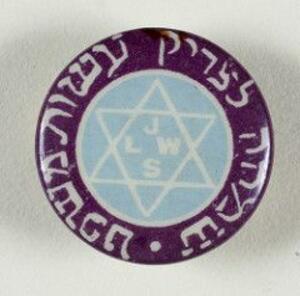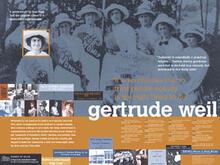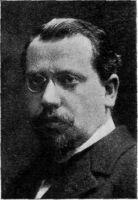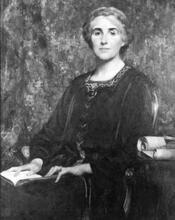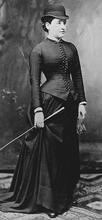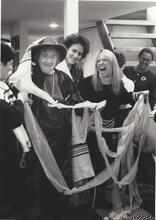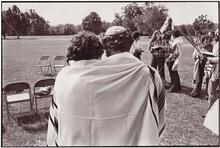Jewish League for Woman Suffrage
Badge (paper, plastic, metal, round, paper) produced by the Jewish League for Woman Suffrage [JLWS], printed with a white star on a blue ground, white inscription in center of star: 'JLWS', purple border, with white inscription in Hebrew, paper covered with plastic, over metal base. TWL.2004.613. Held by the London School of Economics.
The Jewish League for Woman Suffrage (JLWS) was the only Jewish women’s organization in England—and the world—devoted exclusively to obtaining both national and Jewish suffrage for women. Founded on November 3, 1912, the League proclaimed twin goals: to demand Parliamentary suffrage for women and to improve the status of women within Judaism. Many prominent Jewish women, and men, were members of the JLWS and the League frequently collaborated with other religious suffrage organizations. Non-party and non-militant, the JLWS had over 300 members and actively sought to engage Jews living in the East End of London. It largely disbanded at the end of World War I, but many of its members continued to campaign for secular and religious rights for women.
The League’s Foundation
The Jewish League for Woman Suffrage (JLWS) was the only Jewish organization in England—and the world—devoted exclusively to obtaining both national and Jewish suffrage for women. Founded on November 3, 1912, the League proclaimed twin goals: “to demand the Parliamentary Franchise for women on the same line as it is, or may be, granted to men, and to unite Jewish Suffragists of all shades of opinion for religious and educational activities … [It will also] strive to further the improvement of the status of women in the [Jewish] Community and the State” (JLWS, First Annual Report 1913–1914, p. 3).
Prior to the establishment of the JLWS, Jewish women—and men—were prominent members of the British suffrage campaign and its various organizations. A number of religious leagues were established between 1909 and 1912, including the Church League for Women’s Suffrage, the Free Church League for Women’s Suffrage, and the Catholic Women’s Suffrage Society, and the founders of the JLWS argued that “the absence of a Jewish Society advocating Woman Suffrage seemed an invidious exception” (JLWS, First Annual Report 1913–1914, p. 9). Non-militant and not affiliated with any political party, the JLWS was open to both men and women, and by 1913 it had over 300 members. Among its notable members were Ruth Franklin, Lily Montagu, Inez Bensusan, Rev. Dr J. Hochman, Hannah Hyam, Helena Auerbach, Israel Zangwill, Henrietta Franklin, Nina Salaman, Henrietta Lowy, and Rev. A.A. Green.
The Campaign for Suffrage
Linking feminist goals with Jewish devotion, the JLWS combined secular suffragist rhetoric with Jewish terminology. The world’s first Jewish organization to link Judaism with suffrage, the League directed the outlook of Jewish womanhood towards secular, religious, and communal feminist goals. Indeed, the League’s strong feminist commitment became quite clear as it joined national and international secular suffrage organizations. For example, Helena Auerbach represented the JLWS at the International Congress of Suffrage Societies held in Budapest in June 1913.
The JLWS was welcomed by the wider suffrage movement and its creation was announced in numerous suffrage newspapers. A spirit of cooperation and collaboration, most notably with other religious suffrage leagues, prevailed throughout the League’s existence. The JLWS may have been partially responsible for the first interfaith suffrage initiative in 1913. In June it sent a representative to a protest against the Prisoners (Temporary Discharge For Ill-Health) Bill, commonly known as the “Cat and Mouse” Act, and in August it organized a joint protest against forced feeding on behalf of the “Religious Societies for Women's Suffrage.” The JLWS participated in a National Week of Prayer in November 1913, and rabbis often represented the League alongside their Christian counterparts at suffrage meetings.
While the League itself was non-militant, it did have radical members. Henrietta Lowy, a JLWS subscriber, was also a member of the militant Women’s Social and Political Union (WSPU). In 1910, Lowy was sentenced to one month imprisonment for her part in Black Friday, a protest against the failure of the Conciliation Bill (a proposed bill that would have granted some women the vote) that was met with heavy police violence. Lowy’s daughter Gertrude was arrested and sentenced to two months imprisonment for window-smashing in 1912 and was awarded a Hunger Strike medal by the WSPU. In 1913 militants disrupted services in several synagogues in London and one in Brighton, demanding suffrage for women. The most infamous incident took place in October 1913, at London’s New West End Synagogue. Three women interrupted a The Day of Atonement, which falls on the 10th day of the Hebrew month of Tishrei and is devoted to prayer and fasting.Yom Kippur prayer service by shouting “May God forgive Herbert Samuel and Sir Rufus Isaacs for denying freedom to women. May God forgive Herbert Samuel and Sir Rufus Isaacs for consenting to the torture of women.” Herbert Samuel and Rufus Isaacs were targeted as Jewish members of a Liberal government that refused to grant women the vote. The women were forcibly removed and castigated by the Jewish World as “blackguards in bonnets,” although were widely celebrated by the suffrage press.
The London Jewish Chronicle was largely in favor of the suffrage movement, although it did not condone militancy. However, the newspaper’s letters and comments section demonstrated a wide range of opinions. While some voiced support for the League, and for the cause more broadly, contributors debated whether ministers should be voicing opinions on such matters, as well as the implications of joining the movement specifically as Jews. Fear of antisemitic reprisal was evident, particularly in response to militancy, as one contributor asserted “how dangerous it is to us, when Jews take a place in the ranks of the unrest.” Others argued that Jewish participation in the suffrage movement would instead facilitate social integration. The suffrage campaign thus evoked wider contemporary debates about assimilation, antisemitism, and involvement in political questions of the day.
Although the JLWS was primarily made up of the more established upper-middle-class Jewish men and women, in May 1913 it opened a branch in the East End of London, an area where many Jewish migrants, largely from Eastern Europe, settled. The League’s Annual Report noted that at the first public meeting, presided by Dr. Hochman, a number of members were enrolled and a Committee was appointed. The JLWS hoped it would engage a group hitherto unreached by the wider suffrage movement, and press reports suggested that it was successful in doing so. The League distributed Yiddish-language leaflets; similar attempts were made by other strands of the suffrage movement when canvassing in areas with large migrant Jewish populations. The Whitechapel Branch of the London Society distributed leaflets in Yiddish in 1913, and the Women’s Freedom League sought to engage Yiddish-speakers to address voters in the 1908 North-West Manchester by-election.
Promotion of Religious Enfranchisement
In addition to the campaign for political enfranchisement, the League also focused on religious equality. In 1912 it mounted a campaign for votes for female synagogue seat-holders, supported by Liberal rabbis who believed the synagogue should mirror social concerns. The League enjoyed some success in this endeavor, and in May 1913, a resolution to this effect was passed at the New West End and Brondesbury Synagogues. A deputation was sent to the Chief Rabbi Joseph Herman Hertz (1872–1946), who gave his favor to the idea, noting that women seat-holders had the vote in several Orthodox synagogues in America. However, the JLWS Annual Report noted that some difficulty arose from its association with the political suffrage movement and so in March 1914 it established an independent committee to push for female suffrage within the synagogue. The League ultimately failed to convince the United Synagogue to grant the vote to women throughout all congregations, and it would take the postwar campaign by the Union of Jewish Women to expand the religious franchise further.
The Jewish League for Woman’s Suffrage was relatively short-lived, as it largely disbanded during World War I. Many of its members were rewarded with the vote by the Representation of the People’s Act 1918, which granted partial suffrage to women who met certain criteria. Yet its members continued to dedicate their lives to religious, social, and political causes in a wide variety of secular and religious organizations. Despite leaving little historical record, as the first, and only, Jewish women’s organization solely dedicated to gaining national franchise, the League’s importance should not be overlooked.
Adam, H. Pearl, ed. Women in Council. London, New York, Toronto: 1945.
Anglo-Jewish Yearbook. 1921, 189.
Cohen, Percy. “Jews and Feminism.” Westminster Review (October 1913): 457, 461.
DeBruin, Elizabeth. “Judaism and Womanhood.” Westminster Review (August 1913): 130–131.
Edwin Montague letter to Lily Montagu, April 24, 1912. Lily Montagu Papers, American Jewish Archives.
Fawcett, Millicent Garrett. Woman’s Suffrage. London: 1912, reprinted New York: 1970, 86.
Jewish Chronicle.
Jewish League for Woman Suffrage, First Annual Report 1913–1914. The Women’s Library at LSE, London.
Lily Montagu Papers: Ellen M. Umansky Microfilm collection. American Jewish Archives. Cincinnati, Ohio.
Papers. Jewish League for Woman Suffrage. Klau Library, HUC-JIR.
Women’s Social and Political Union. Annual Reports 1907-1913. The Women’s Library at LSE, London.
Votes for Women.
Common Cause.
The Suffragette.
Crawford, Elizabeth. The Women’s Suffrage Movement; A Reference Guide, 1866-1928. London: UCL Press, 1999.
Kuzmack, Linda Gordon. Woman’s Cause: Jewish Woman’s Movement in England and the United States, 1881–1933. Columbus: Ohio State University Press, 1990.
Renard, Carole. “Jewish involvement in the women’s suffrage movement in Britain: navigating multiple identities in the Diaspora.” Jewish Historical Studies, Vol. 48, No. 1, 2016: 158-176.
Summers, Anne. Christian and Jewish Women in Britain, 1880-1940. Living with Difference. London: Palgrave Macmillan, 2017.

